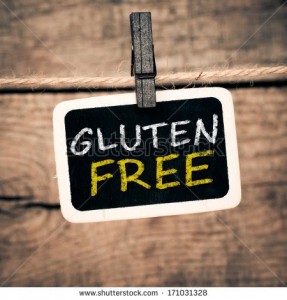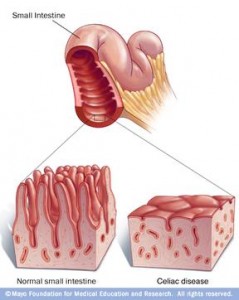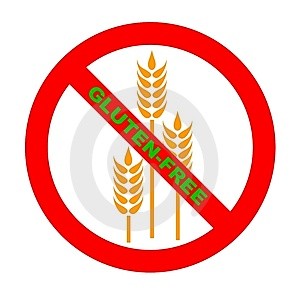 Anyone who has ever dealt with gluten issues knows that feeling when they have been exposed to gluten- bloating, stomach discomfort, joint pain, and fatigue. The list goes on and on. Every person is different with their symptoms, but one thing stays the same… those of us with Celiac Disease and gluten-sensitivity spend our lives avoiding anything with wheat, barley, or rye.
Anyone who has ever dealt with gluten issues knows that feeling when they have been exposed to gluten- bloating, stomach discomfort, joint pain, and fatigue. The list goes on and on. Every person is different with their symptoms, but one thing stays the same… those of us with Celiac Disease and gluten-sensitivity spend our lives avoiding anything with wheat, barley, or rye.
Gluten is actually a term used for two proteins in foods, gliadin and glutenin. These two proteins help make foods like bread, cakes, muffins, and pastries fluffy and moist. It’s common to hear when people try gluten free foods for the first time, especially if it’s not well-made, that the food is dry and hard. This is because the sticky factor gluten creates in foods is missing.
 When someone who has Celiac Disease eats food with gluten in it, their immune system attacks their intestines and food isn’t absorbed. In our gastrointestinal track, we have little finger-like structures, called villi, that help in the absorption of food. These villi are damaged when gluten is eaten. Over time as the villi are continuously damaged, the body can’t absorb foods, and some people become malnourished, and vitamins and mineral deficient.
When someone who has Celiac Disease eats food with gluten in it, their immune system attacks their intestines and food isn’t absorbed. In our gastrointestinal track, we have little finger-like structures, called villi, that help in the absorption of food. These villi are damaged when gluten is eaten. Over time as the villi are continuously damaged, the body can’t absorb foods, and some people become malnourished, and vitamins and mineral deficient.
In 2012 I found out that I had Celiac Disease. My mother made the suggestion to me, after I had complained of constant joint pain for almost a year, she thought I had an issue with gluten. I laughed her off and told her the idea was ridiculous. After some serious persuasion, I agreed to go gluten free for 2 weeks to see if anything changed. Guest what? Just like mothers always are, she was right! From there, I embarked on the gluten free lifestyle, and thanks to a wonderful physician at Penn Medicine I was able to confirm my suspicions.
Since then, I’ve lived a completely gluten free lifestyle. It’s not easy at time, but my pain, fatigue, and GI discomfort are completely gone, and my health and happiness are worth every effort. I welcome Celiac Awareness Month, because it gives me the opportunity to educate and offer suggestions to others who battle the same problem and/or know someone with gluten problems. Click on the links for more information about testing for celiac disease or to learn about some of the differences between Celiac disease and Non-Celiac gluten sensitivity. It is often recommended that persons with an autoimmune disease get tested for celiac, including Type 1 diabetes, hashimoto’s autoimmune thyroid disease, and more.
Here are some of my favorite websites and resources for dealing with gluten issues:
- National Foundation for Celiac Awareness
- Celiac Disease Foundation
- Ultimate Gluten Free: Traveling is never easy with this problem, but I use this website to help me with airports.
- Find Me Gluten Free: If I’m traveling by car or trying to find a place to eat, I use this website (or app for your iPhone.) This app has saved me a lot of headaches on more than one occasion.
- Where is Gluten Hiding in Your Life? This website really helped me with hidden gluten products. After reading this, I learned to read every label.
- Gluten in Processed Foods and Beverages is another go-to article that I suggest for people who are just starting out on the gluten free lifestyle. I found it very helpful with reading ingredients.
- Google: My last resort when I’m not sure if something is gluten free is to Google it. I usually type in the product name and “gluten free.” The internet is an amazing place for those of us with food issues.
 One of my biggest challenges with going gluten free, besides the cost, was learning to bake with gluten free flour, which is very costly. I’ve found that mixing a variety of flours allows for desserts that more closely resemble regular desserts, and it is cheaper, because you can buy the flour in bulk.
One of my biggest challenges with going gluten free, besides the cost, was learning to bake with gluten free flour, which is very costly. I’ve found that mixing a variety of flours allows for desserts that more closely resemble regular desserts, and it is cheaper, because you can buy the flour in bulk.
I found this recipe a few years ago that I use and honestly I am not sure of the original source.
Ingredients:
- 3 cups brown rice flour
- 1 cup millet flour
- 1 cup tapioca starch or tapioca flour
- 1 cup potato starch
Preparation:
Mix together in a bowl and store in an air-tight container. The gluten-free flour blend does not need to be refrigerated.
Substitute this flour blend for regular flour in most recipes. When baking, for every 2 cups of this gluten-free flour blend, add 1/2 teaspoon of xanthan gum or 3/4 teaspoon of guar gum unless the recipe states otherwise.
See my Healthier Holiday Treats blog for gluten free Red Velvet Cupcakes and my Ghosts, Goblins, and Healthy Halloween Treats blog for gluten free Pumpkin Muffins. Also, check out our resource page which has many gluten intolerance related resources.
Enjoy,
Megan
Megan Carrier
Eat Fit Health Intern
Graduate Student, Drexel University
MS in Human Nutrition